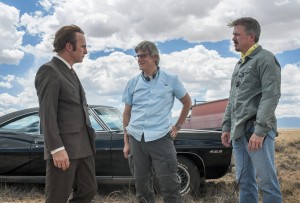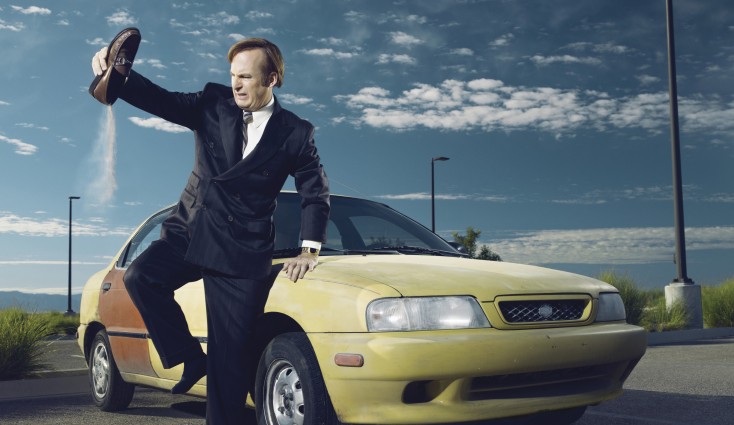
(l-r) Bob Odenkirk as Saul Goodman on the set of BETTER CALL SAUL with executive producers Peter Gould and Vince Gilligan ©Jacob Lewis/AMC
By JUDY SLOANE
HOLLYWOOD—For “Breaking Bad” fans who have eagerly anticipated the spinoff series “Better Call Saul,” the wait is nearly over.
The new series, starring Bob Odenkirk reprising his slippery ambulance-chasing lawyer Saul Goodman character, premieres on AMC Sunday, Feb. 8 at 10/9c.
The show’s executive producers Vince Gilligan and Peter Gould, spoke at the Television Critics Association Summer Press Tour about the hour-long TV comedy, which is a prequel to the much-acclaimed “Breaking Bad,” which aired on AMC from 2008 to 2013.
Set in 2002, the series follows the misadventures of Saul, and introduces new characters, including Michael McKean (“Spinal Tap,” “Best in Show”) as Saul’s brother, Chuck. Additionally, some characters from the original series are scheduled to return (Jonathan Banks, who played no-nonsense P.I. Mike) or make guest appearances. Naturally, Gilligan and Gould didn’t want to give away all the surprises in store in this first batch of 10 episodes. Gilligan, the creator of “Breaking Bad” and a former “X-Files” writer, explained that while “Better Call Saul” is set in the same universe as “Breaking Bad,” it has to stand on its own to succeed as a series. Otherwise, it simply becomes a clip show. He also explained why the series premiere was pushed back from its original scheduled date last fall.
Q: How limited are you by where Saul goes by the end of “Breaking Bad?”
Gilligan: It’s a challenge, but we’re having fun, and we’re plugging away. It’s like being really into this Rubik’s Cube you’re trying to solve. Although having said that, I’ve never actually solved one in my life.
Gould: It reminds me a lot of when we started Season 5 (of “Breaking Bad”) and we had the machine gun in the trunk, and we knew that it was the right image, but we had no idea how the hell we were going to get there.
Gilligan: Or what it was going to be used on or how it was going to be used. It’s a leap of faith—or stupidity—into the unknown. I thought it was going to be kind of easy going forward, “Ah, we know who this guy is.” But we didn’t really know who this guy was at all. He was a really interesting supporting character, and suddenly Peter and I are taking long walks around our old “Breaking Bad” writers’ offices, saying, “No, wait a minute, how does this work?” So it’s a very interesting process. There are certain limits that you have, obviously. We know where this guy is going. We can’t, for instance, in the first episode have him lose an arm or an eye or something like that.
Q: Is there an equivalent of the machine gun in the trunk that you’ve either written into the pilot for this or something from “Breaking Bad” that you know you have as a point that you’re aiming at?
Gould: I would say the character you meet in that sort of was our kickoff point.
Gilligan: “Breaking Bad” itself, in a certain way, is the machine gun in the trunk because we know that that’s where the guy is going to end up. It’s a challenge because we know that (Saul Goodman) is not the name he was born with. One of the questions we ask ourselves a lot is: what problem does becoming Saul Goodman solve?
Q: In “Breaking Bad,” Walt met (drug distributor) Gustavo “Gus” Fring through Saul. Of all the characters you could bring back, it seems like Gus would be one of the most obvious ones. Is there any chance of bringing him back?
Gilligan: There’s always a chance, yeah.
Gould: These are all characters we love. There’s so much more to say about that character, and we certainly love Giancarlo (Esposito). There’s always a possibility. Having said that, we’re trying to make something that stands on its own that has entertainment value, that’s not just seeing a series of old favorites or remember when. It’s not the series equivalent of a clip show. We try to balance these things out. But I agree there’s so much to be said about Gus. It always seemed to me on “Breaking Bad” that Saul didn’t know Gus directly. He knew a guy who knew a guy who knew another guy.
Gilligan: Yeah. I don’t think it’s giving anything away to say we’re still feeling our way through this. We’re figuring out just how, if and when to see some of these characters.
Q: At what point did you know you weren’t going to make the original premiere date? And did it have anything to do with how much pressure is on this and expectations?
Gilligan: We could have made the deadline (but) I am slow as mud as a TV writer. I always have been. We had a pace, thanks to AMC and Sony, on “Breaking Bad” that was deliciously stately for television. We have a way of doing things that is slower than most TV shows. We averaged three weeks per episode just breaking episodes. Lo and behold, we’re doing the same thing with “Better Call Saul,” because we want to think everything through, and we feel that that pays dividends. Thanks to AMC and Sony, we had time to think everything through.
Q: What went into the thinking of the Saul Goldman character as a spinoff?
Gould: We made the choice to follow this character because he intrigued us and because we didn’t feel like we were finished with the world in “Breaking Bad.” We hope we’re true to the tradition. I think the tradition of “Breaking Bad” that we’re going to be most true to is the tradition of having something that’s sweated over, that’s worked out as best we can, where there’s a tremendous attention to detail and also where there’s some showmanship.
Gilligan: Then we will let the chips will fall where they may. But anything worth doing is worth taking the risk of abject humiliating failure over. Hopefully, that won’t happen.
Q: What was your inspiration for creating Saul in the first place?
Gould: I did originate him, but everything that came out of the “Breaking Bad” writers’ room and everything that comes out of “Better Call Saul” writers’ room is a group effort. This is all work that we do together, and I think the evolution of Saul came about really because there was a gap or opening in the “Breaking Bad” universe. In “Breaking Bad” Season 2 we had planned originally to be all about Walt and Jesse versus Tuco (Salamanca, a Mexican drug lord), and then because of the actor’s scheduling, we essentially had to kill Tuco in Episode 2, and we were left with the situation where we had these two guys who were great at cooking meth but ***** at selling it.
We started thinking about what are the problems they’re going to have? How are these guys going to evolve as characters but also in a business? We realized we needed somebody to help them if they got into a particular situation where if you’re doing the things that they’re doing, some people are going to get arrested, you’re going to need a lawyer. We talked a lot about this character Saul Goodman, and it was a leap into the void for me. In a lot of ways, Hank (Walt’s police officer brother-in-law) was one of the most amusing characters. The relationship with Walt and Jesse was very funny. I feel like Saul kind of moved the universe two degrees to the left.
Q: Did you have any reservations about adding another element of humor?
Gould: I was so worried that somehow we were going to break open the “Breaking Bad” universe and he wouldn’t quite fit. He’d be this puzzle piece that didn’t quite fit. Vince had a vision for this universe that none of us completely encompassed, and lo and behold, this weird puzzle piece of Saul Goodman who is this slippery lawyer in the crazy suits in the crazy office, fit. He made the drama more dramatic and the comedy (funnier).
n a lot of ways, Saul Goodman was about solving a problem, but it also was so much fun to write a character that was this slippery and loquacious. We had Walt White who got deeper and heavier and, of course, Bryan (Cranston) was always very funny. But there’s a heaviness to Walter White, a depth, and here we had this other character that was kind of skidding over the top of the waves in the scene, and for some reason, it seemed to work.
Q: What is the setting for “Better Call Saul?”
Gilligan: It’s 2002. We never completely nailed down when “Breaking Bad” took place. We shot the pilot in 2007. We tried hard to not be too specific as to when it was, but now we have to kind of be a little more specific than sometimes we’re comfortable with. It’s funny, you learn so much from your actors and your crew. In one of the first meetings, our Teamster captain who was in charge of finding picture vehicles and our hair and makeup folks were saying to us, “So 2002?” And I said, “Yeah,” and they said, “Well, we need period‑specific cars.” I’m like, “Oh, yeah, right.”
Q: Can you reveal any details about the new characters?
Gould: We have Michael McKean playing a character named Chuck, who is Saul’s brother. So we have these two comedy legends working together, which is kind of exciting. He’s one of the main characters we’ve introduced.
Gilligan: I was fortunate enough to work with him “The X‑Files” and on “The Lone Gunmen.” It was great getting reacquainted with him because I hadn’t seen him in since 2002, because that’s when “The X‑Files” ended. Then we got Rhea Seehorn (who plays Kim Wexler), who is a wonderful actress. She is just as cute as she can be and just a wonderful, funny actress, but also capable of a great deal of depth.
Gould: There are a lot of lawyers and crooks. I know that will come as a big surprise.
Q: There have been reports about the show maybe not following a complete linear narrative and jumping back and forth in time and maybe having some action taking place during the events of “Breaking Bad” and some even after. Is that something you’re still considering? Or is it a straight prequel?
Gilligan: The best way to answer this and not get into trouble is that you saw from “Breaking Bad” that we like nonlinear storytelling. We like jumping around in time. I would definitely point you in the direction of anything that was possible on “Breaking Bad,” storytelling-wise, is possible on “Better Call Saul,” because it’s fun. It’s fun for us to be as nonlinear as possible.





